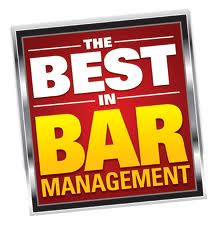 www.BobTheBarGuy.comphone number: (800) 447-4384
www.BobTheBarGuy.comphone number: (800) 447-4384
Every bar is different. Popular liquors are pretty much the same from bar to bar, but how it gets to the customer—the pour, the glassware, the way it’s made and garnished, and how it’s priced—can vary. So we put the same pour spouts on all the bottles and encouraged the owners to “control the pour.” No more count system (they had four different types of spouts on the liquor bottles, each one wider or faster than the other). They agreed to a controlled pour, went with a 1¼ oz. metal jigger across the board, and made it a requirement that all bartenders measure each shot of liquor. This technique will lower their portion controlrelated losses by 3 to 5%.
A “doghouse” concept was created and implemented (back-up bottles and storage area for each brand of liquor at the bar). They no longer had the operational crisis of running out of liquor at the bar on a busy night. It would never happen again.
Next, we addressed glassware. The highball glass they were using was ten ounces, their shots 1¼ ounces. This was causing the bartenders to over pour each shot in order for the drink to taste right using the correct amount of mix to liquor. This adds up over time.
I explained to the owners the importance of enforcing a drink recipe manual for their bartenders. No bartender should be allowed to make drinks their way. The house gives the bartenders the recipes for all drinks, how they’re to be made, and how they are priced. Bartenders should be routinely tested on the house drink recipes.
We then created inventory control forms for all parts of the liquor inventory. This included a Liquor Requisition form (accounting for the empty bottles at night’s end); Storeroom Perpetual form (accounting for the daily movement of liquor into and out of the storeroom);
We then created inventory control forms for all parts of the liquor inventory. This included a Liquor Requisition form (accounting for the empty bottles at night’s end); Storeroom Perpetual form (accounting for the daily movement of liquor into and out of the storeroom);
Ending Inventory Count form (the physical counting of the liquor at week’s/month’s end); Usage/Cost form (gives you an Operational Pouring Cost percentage and an Actual Pouring Cost percentage number at the end of the reporting period); and an Order form (for all liquor products by vendor). Utilizing these forms creates day-to-day accountability for the liquor inventory and a way to hold the bartenders accountable for what they do.
Of course, the draft beer program was out of control. They were using frozen mugs and pitchers, and they were wasting at least half a keg per brand because of the constant foam problem. We stopped that by simply lowering the temperature in their walk-in cooler to 36 degrees (from 42 degrees) and going to refrigerated glasses instead of frozen. I told them to call their beer distributor and have them install separate pressure regulators for each brand of beer so the internal keg pressure in each brand of draft will equal the amount of pressure coming from the CO2 canister, thereby reducing the amount of foam. Bartenders were taught to open the tap handle from the base of the tap handle, not the top, thereby reducing the pressure that creates foam on the pour.
In doing all this, the number of kegs they had to order each week was cut in half (half!). The beer companies won’t like it, but too bad. I asked them if a beer company ever volunteered to help them out with their foam problem. Of course not! Their taco bar sells a lot of draft beer, and these changes saved big bucks. [Ed. note: See page 34 for more information on draft beer management.
The owners of this bar/restaurant were very experienced with food service, but had never worked in a bar before. They had no bar skills, yet found themselves in a position of having to make serious, daily operational calls. They hired a bartender/bar manager with 12 years of experience, but his knowledge was still limited. He said he knew a lot about the business, but my conversations with him put him in the same category as so many supposed bar managers—they’re nice people, they mean well, but they don’t know a lot! And it’s not their fault. There are no schools, to my knowledge, that teach “How to run a bar.” You learn by the seat of your pants (and by reading Bar Business Magazine). You bring something with you from the last place you worked that you think will help the new place. Usually, it’s bad habits and bad theory. Not good for the old place, not so good for the new place, either!
I could go on about the improvements we made for this client, like the changes in controlling every bottle of beer, wine, champagne, and energy drink, correcting the tip reporting, and numerous other human resource discrepancies, but I think you get the point. There is so much a qualified bar consultant can do to help you realize the profit potential of your business.
My session with these nice people lasted about five hours. In that time I estimate I put in their pocket—if they follow through with all the changes I suggested—at least an additional $90,000-$120,000 in profit per annum, and probably more.
As such, I recently had a conversation with another bar owner in Augusta, Georgia, who said to me, “We should have hired you before we opened. I know you would have saved us at least $200,000.”
So why didn’t he?


